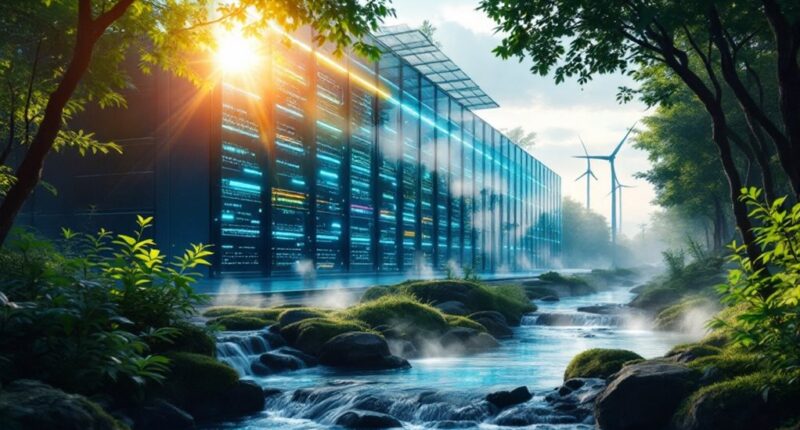AI’s energy consumption is on the rise, with projections of up to 18.7 gigawatts by 2028. That’s enough electricity for a small city! Training models like GPT-3 devour energy equivalent to 130 homes in a year. This increasing demand strains our environment, with some AI models matching the annual carbon emissions of ten average French folks. However, innovative solutions like energy-efficient algorithms and green technologies are stepping up to balance tech wizardry with sustainability. Curious about the latest?

In the ever-evolving landscape of technology, AI is like that friend who shows up to the party with a dazzling array of talents but also has a knack for leaving a hefty energy bill behind. As the demand for AI surges, its energy consumption is projected to hit a staggering 14 to 18.7 gigawatts by 2028. To put that into perspective, training just one AI model, like GPT-3, uses energy equivalent to what 130 average U.S. homes consume in a year. Talk about a party crasher!
AI dazzles with talent but leaves an energy bill that skyrockets—training a single model can power 130 homes for a year!
Data centers, the unsung heroes of the AI revolution, currently account for about 1-2% of global energy demand, similar to the entire airline industry. However, by 2030, AI alone could represent a jaw-dropping 21% of this demand. The carbon footprint of AI is equally alarming, with some models emitting as much carbon as ten times the annual emissions of an average French person. And as data centers expand, so does their thirst for energy and water for cooling—Google and Microsoft have seen their water usage spike dramatically in just one year. AI-driven energy management innovations like power-capping hardware can reduce energy consumption by 15% without sacrificing performance. New chips designed for efficiency and smaller AI models are also emerging, promising to lighten the load. AI can even help combat its own carbon footprint—smart home devices could reduce household CO2 emissions by up to 40%, while AI-guided flight paths can notably lower aviation’s environmental impact. Furthermore, the increased data center usage highlights the urgent need for more power to support AI infrastructure, underscoring the challenges we face.
However, challenges remain. The processing power needed for AI is doubling every 100 days, making energy consumption a pressing concern. To tackle this, the industry is increasingly focusing on “Green AI,” developing energy-efficient algorithms and promoting renewable energy sources. As we navigate this intricate dance of innovation and sustainability, the future of AI hinges on finding the balance between its dazzling capabilities and the environmental costs it entails.
Frequently Asked Questions
How Does AI Impact Energy Consumption in Different Industries?
AI’s impact on energy consumption varies across industries, like a chameleon at a paint factory. In manufacturing, it optimizes processes, reducing waste like a chef perfecting a recipe.
In transportation, AI fine-tunes route planning, saving fuel as if every car was on a diet. Meanwhile, in the energy sector, it enhances grid management, ensuring smooth distribution.
Yet, with great power comes great responsibility—AI’s own energy needs can be substantial, raising eyebrows.
What Are the Environmental Effects of Data Centers Powering AI?
Data centers, the unsung powerhouses of the digital age, come with a hefty environmental price tag. They guzzle electricity, contributing to 0.3% of global carbon emissions, while their thirst for water rivals that of entire nations.
Training AI models can belch out staggering CO2 emissions. Picture a factory of tech giants—Google, Microsoft—pumping out emissions like there’s no tomorrow. As these centers grow, so do their impacts, straining resources and ecosystems alike.
Are There Regulations for Ai’s Energy Consumption?
Regulations regarding AI’s energy consumption are gradually emerging, akin to a cautious dance between innovation and sustainability. The EU’s forthcoming AI Act and ISO’s sustainable standards aim to guarantee transparency in energy use.
Meanwhile, the U.S. is pushing for bills to assess the environmental footprint of AI systems. Yet, measuring energy consumption remains tricky, like trying to catch smoke with bare hands. As the tech world spins forward, balancing these demands becomes increasingly essential.
How Can Consumers Reduce Ai-Related Energy Usage?
To reduce AI-related energy usage, consumers can make smart adjustments. They might enable power-saving modes, lower screen brightness, and limit background processes—think of it as putting their devices on a diet.
Choosing energy-efficient AI services is essential too; opting for green cloud providers or offline capabilities can save power.
Finally, managing data usage by using Wi-Fi and clearing caches regularly helps keep energy consumption in check—like decluttering a messy garage, but for tech.
What Role Does Renewable Energy Play in AI Development?
Renewable energy plays a pivotal role in AI development, acting like the secret sauce in a gourmet burger. By powering data centers with clean energy, companies can reduce the carbon footprint of energy-hungry AI processes.
Solar and wind energy not only meet increased electricity demands but also enhance efficiency through smart grids. Plus, AI helps forecast renewable energy production, ensuring a steady supply—like knowing when to water your plants before the rain comes









